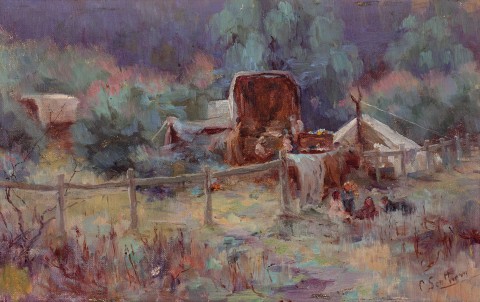THE CHRISTMAS CAMP
CLARA SOUTHERN
oil on canvas
25.5 x 41.0 cm
signed lower right: C. Southern
inscribed with title on stretcher bar verso: The Christmas Camp.
bears inscription verso: By Clara Southern / C Southern
bears inscription on frame verso: Mr G P Cooper / … / 6 Waltham St. / Richmond
Mr George Page Cooper, Melbourne (bears inscription verso)
Private collection
Leonard Joel, Melbourne, 4 November 1987, lot 65
Earl Gallery, Victoria
Private collection, Victoria, acquired from the above in November 1987
Exhibition of Australian Paintings, Earl Gallery, Victoria, nd, cat. 6 (illus. in exhibition catalogue)
We are grateful to Brenda Martin Thomas, wife of the late David Thomas AM, for kindly allowing us to reproduce David's research and writing in this catalogue entry.
Clara Southern is widely regarded as one of the leading women artists of Australian Impressionism. During this Golden Age of Australian art, she and her colleagues Jane Sutherland and Jane Price were considered to be the three leading female figures. While Sutherland is usually given prime position, many would agree with arts writer and historian John McDonald who stated that '...one could make a credible case for Clara Southern... as the most significant woman artist of the era.’1 Perhaps this is an honour that will be achieved when her achievements, such as The Christmas Camp, become wider known.
Southern studied under Madame Mouchette at the National Gallery School, and under Walter Withers at his home in Heidelberg. Her fellow students at the Gallery included Arthur Streeton, Sutherland and Emanuel Phillips Fox. Although she worked in the open air directly from the motif, and made weekend painting trips to Eaglemont artists' camp, her view of the landscape is as if seen through women's eyes. In her more lyrical approach to the Australian scene she reflected the beneficial influence of her teachers Frederick McCubbin and Withers, avoiding the heat and blinding light of the noonday sun for quieter moods of nature. Like her fellow women artists, she preferred a more domesticated bush to one populated by male heroics. Moreover, her settled countryside is often peopled with women as in An Old Bee Farm, c.1900, acquired by the National Gallery of Victoria, Melbourne, through the Felton Bequest in 1942. An Old Bee Farm and other major works were included in her exhibition at the Athenaeum Hall in 1914. The exhibition confirmed that her best landscapes were painted at Warrandyte. Following her marriage to John Flinn in 1905, they moved to Blythebank at Warrandyte. She lived and painted there for the remainder of her long life. Here Southern became a central figure in a growing community of artists who at times included Louis McCubbin, Penleigh Boyd, and Harold Herbert. Clearly a leader of her time, she exhibited with the Victorian Artists' Society from 1889 – 1917 and was not only the first female member of the Australian Art Association but the first to serve on its committee. Memberships included the Lyceum Club and the Melbourne Society of Women Painters and Sculptors.
Southern’s love of the Warrandyte countryside is readily apparent in The Christmas Camp through its soft, magical blues, mauves, fresh greens, and the relaxed charm of the artist’s camp nestled within the landscape. Enveloped in an atmosphere that is palpable, the work encapsulates her close identification with the scene, passionately embraced on first sight and maintained throughout her life; as elucidated by one contemporary critic at the time of the Athenaeum exhibition in 1914,
‘Miss Clara Southern (Mrs J. Flinn) is a sweet and original singer of the Australian bush in colour, which, by the most skilful use of her pigments, she realises in all its beauty and charm, its majestic silences, its harmonies, and those mysterious distances we all know and feel when in its midst. We can almost hear the wind sighing and sobbing through her trees and that furtive movement of life beneath the beautiful undergrowth that trembles in her foregrounds. Her landscapes are truly poems, full of sentiment and feeling, and that artistic reticence so seldom met with, which never allows nature to be for one moment oppressed or overstepped, or the note forced under any pretence.’2
1. McDonald, J., Art of Australia, Pan Macmillan Australia Pty Limited, Sydney, 2008, vol. 1, p. 606
2. ‘A Lyrical Painter’, Kyneton Guardian, Victoria, 14 March 1914
